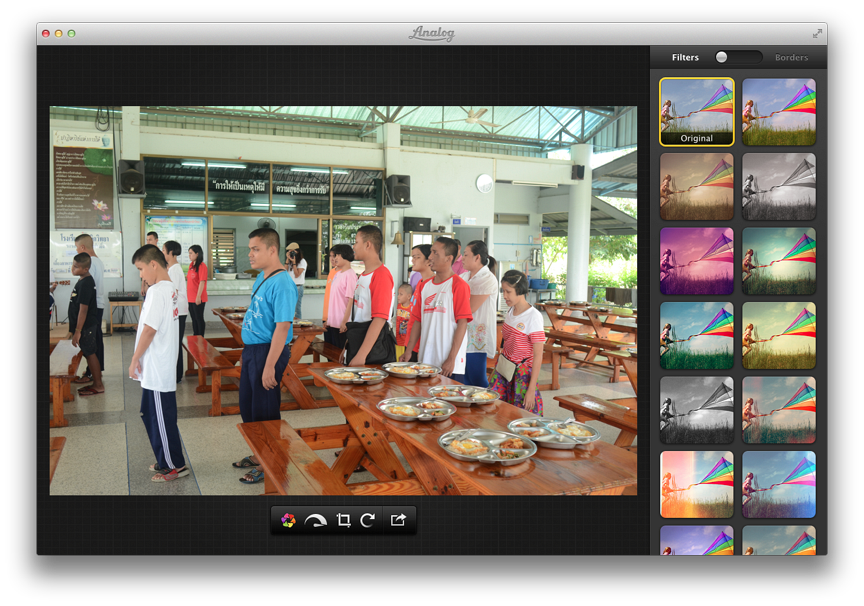Analog Camera: Mac app heading for the iPhone

AMITIAE - Tuesday 15 May 2013
|
Analog Camera: Mac app heading for the iPhone |
 |
|
|
By Graham K. Rogers
Realmac have focused on the core features that were important - "stunning filters, incredibly fast and easy to use". In the enclosed text release, they also emphasise the fun aspect. The app will have a beautiful fluid interface, we are told: screen shots and video available indicate the design aspects have a high priority.

New Image Manipulation Application: Analog - Interesting but may Need Beefing up (Amended)
Analog applies filters to digital images and the ease of use on a scale of 1 -10 is 11. There are 19 filters to choose from, plus Original [now 27]. A simple switch above the filters allows us access to Borders. In a similar panel -- displayed two by two, users have a selection of 13 filters [now 15] (plus original). Some of these make the finished image look like old film, with sprocket holes or film roll numbers beneath. The filter effects and the borders are applied almost instantly: a gear wheel turns for a moment or so.

The Toggle control changes the image back and forward: between the image with effects and the original without. When taking the effects Off, this was almost instant. However, when toggling the effect back ON, there was a lengthy delay and the computer slowed. After trying this a couple of times, the process became a little faster. I also experienced considerable slowing when trying to open a second image using a Finder window. Once the image was displayed, the effects were applied easily and the processing was at the initial reasonable pace. With the Crop command, a useful grid was placed over the image and the crop could be effected either using a tool with preset sizes, or an adjustable window. A check icon to the right accepted any change made. Rotate turned the image 90 degrees clockwise each time the icon was pressed. There was no anticlockwise toggle as far as I could tell.
I exported an image that in its original form was 4928 x 3264. The saved version was 1708 x 1276 (just under 24" x 18"). While manipulating the images there were several processing delays, and the spinning wait cursor appeared for lengthy periods. Work in other open applications (for example typing in a text editor) was also delayed. I quit and restarted the application, but the process was rather slow. I then opened smaller images and Analog was far better behaved. Looking at the intended export sources it is clear that this application has a limited intent: image effects and sharing, particularly using social networking sites, so the type of large image that I had initially tried, would not be what most users will be using.
As an image manipulation application, its easiness makes it a useful addition to the collection of software for anyone who might want non-standard images -- with some interesting effects -- that can be processed and exported quite quickly to a number of popular sites.
Graham K. Rogers teaches at the Faculty of Engineering, Mahidol University in Thailand where he is also Assistant Dean. He wrote in the Bangkok Post, Database supplement on IT subjects. For the last seven years of Database he wrote a column on Apple and Macs. |
|

For further information, e-mail to

|

|